
Natalie Livshitz
Contributor
Students across Ontario are banding together in protest after learning that the province tops the
nationwide ranking for the highest tuition fees.
According to Sandy Hudson, chair of the Canadian Federation of Students Ontario (CFS-O), students in Ontario have to pay over $6,000 annually.
“It is simply unfair because students who reside in another provinces [may] be paying $2,500,”
said Hudson.
Keith Marnoch, York’s associate director of media relations, noted the university does not “dream up [the tuition fees]” and wanted to remind students fees are set according to a provincial government
framework.
York is working with the provincial government to secure “more sustainable funding,” he added.
Hudson noted that the CFS-O launched the “Education is a Right” campaign in September 2010 to combat provincial inequality in tuition fees.
“What we’re calling for is a post-secondary education act that would ensure equality across the board when it comes to post-secondary education policies,” she said.
Hudson also explained how the post-secondary tuition hike affects marginalized groups as well as visible minorities, people with disabilities, women and
aboriginal students.
“Because of the […] economic and financial realities of these groups in our society, and the systemic discrimination that these groups deal with, they have a lower chance of accessing post-secondary education because of the cost,” she said.
Jade Macri, a first-year human rights and equity studies student, works two part-time jobs in order to cover her tuition fees, despite the fact that she was awarded an entrance scholarship.
“If I stop working, I wouldn’t be able to cover the tuition fees,” said Macri.
However, not all students oppose the increase in tuition fees.
Amit Praharaj, a first-year environmental studies major, said he felt that the rise in tuition fees in Ontario is justified.
“In different provinces, it’s a different case,” he said. “They’ve got more funding and less things to worry about in terms of infrastructure in their provinces.”
However, students should be compensated for the time and money invested into post-secondary education, he said.
“If the Ontario government can’t find a way to get some kind of funding for the education system, maybe they have to find a way to give [the money] back,” he suggested. “Maybe drop the taxes for students graduating and trying to pay OSAP” said Praharaj.
Darshika Selvasivam, vice-president of campaigns and advocacy of the York Federation of Students (YFS), said that the YFS plans to lobby members of parliament at the provincial and federal levels during the Canadian Federation of Students’ upcoming lobby week.
By doing that, said Selvasivam, the YFS would be able to communicate how the students are feeling and illustrate the effects rising tuition fee costs have on students.



When the NDP were in government, they eliminated needs-based grants and increased tuition fees by 50%.
When the PC Party was in government, they cut over $430 million in just the first two years. Tuition increased by 71% by 2001, and cut student assistance by 50%.
In total, more than $630 million in funding was cut from 1990-2001, and government grants were cut by over 40% in the same time period.
After more than a decade of cuts, Is it any surprise that Ontario students pay the most in tuition?